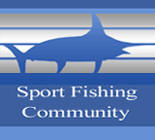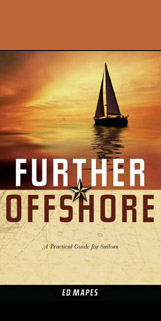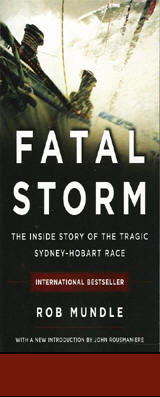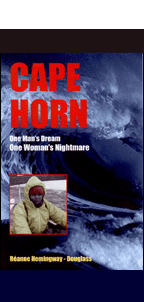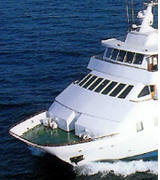|
|
“Maitenes II in the Fastnet race—an account of her ill-fated passage last summer” By L. Luard
appearing in Yachting Magazine.
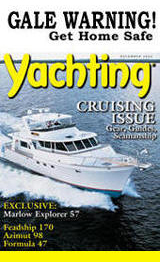
Though there was a record entry list for last year’s Fastnet Race, and
though the leading ships completed the course in record time, the loss
of Colonel Hudson, part owner of Maitenes II, was a tragedy about which
it is difficult to write. . “But the Fastnet Race had, like other
sports,” a friend said afterwards, “to claim sometimes its first victim,
and in course of time it will doubtless claim others. The sea, like war,
prefers the best.”
The last sentence is a true epitaph. The sea, like war, claims the best.
Friendship, devotion, loyalty, were his only watchwords: his loss is,
more than ever, our loss.
The crew of Maitenes numbered nine, all told—eight amateurs, and a young
paid hand who had crossed the Atlantic with us a month before and had
proved of sterling worth. Moreover, we still had aboard two young
American amateurs who also crewed in that ocean race, knew the ship from
truck to keelson, and were able seamen. But all were able seamen; all
had participated in ocean races before. Maitenes, in this race, had a
stronger crew than in the Transatlantic Race, was manned, without doubt,
by a crew as good as any she had seen—if not better.
Small wonder, then that we felt elated. The weather was fair, our time
allowance good, our position in the fleet difficult to better; for
shortly after rounding St. Catherine’s Point, and before dark completely
circumscribed vision, we sighted what appeared to be Patience and
Highland Light standing in from seaward—astern. Though hard pressed by
Dorade, we were apparently leading the fleet, boat for boat with Noreen.
A fine sunset contradicted the weather report of an approaching
depression; the glass held steady; the air was dry; the wind showed
signs of veering; and no swell from the southward troubled the sea. As
in former years, we decided on an inshore course for the time being, on
a gamble with the tides off headlands and in the bights of the coast;
for, without doubt, there was more to gain by pursuing this course, if
we succeeded in our tactics, though a great deal to lose if we failed.
The weather had to be risked. If the approaching depression held off for
twenty-four to thirty hours—all should be well. Everything pointed to
this delay; and we had learned long ago when in the channel, to put more
trust in the traditional weather lore of the fisherman than in the
official forecasts broadcast form Daventry.
Night fell to a full sail breeze, and Maitenes, close-hauled, wsa on her
best point of sailing, though unable to give of her best, as our
mainsail, stretched and worn by the incessant slatting it had undergone
in the Transatlantic Race, had lost some of its shape and set too full
in the luff.
Shortly after midnight the wind backed a full point, heading us off to
west by south, and Anvil Point came abeam; an hour later we were heading
west-southwest, but making good way. We held this course till the
approach of dawn; and at 2:40 A.M., Portland, a point and a half before
the beam, bore N.W. ½ N. with Anvil at N.E. by E ½ E. We still had over
an hour’s tide in hand, and another hour after that before the foul
stream became of any strength; and though the glass was showing a
tendency to fall, the drop as yet was negligible.
Yet a reconsideration of the inshore course was obviously desirable, and
tactics for the new lap had to be decided within the next hour or less.
We had undoubtedly reaped the benefit of the first fair tide, after
successfully cheating two foul one; but our position gave us a clear
alternative of continuing on the offshore tack till we could come about
and lay the Lizard. If the wind backed within the next twelve or fifteen
hours the gain would more than compensate for any loss experienced in
failing to cheat the oncoming easterly stream; if, on the other hand,
the wind held true and steady Lyme Bay was our obvious objective. We
looked anxiously at sea and sky as dawn started to break, saw the glass
had steadied again, and made our decision.
At 4:30 A.M. we tacked inshore, heading northwest by north—and sighting,
in the crepuscular light, Dorade standing away on the starboard tack.
For a moment I almost decided to tack again, and sail boat for boat with
her; and had we done so there would have been a different story to tell.
But this course of action was disastrous. If right in theory it proved
wrong in practice; for no sooner had we sighted Lyme Regis and tacked
seaward again than the wind fell away to a fickle breeze. All that day
we struggled across Lyme Bay to light, baffling, and tantalizing head
winds—unable to reach the steady breeze we could see on the water a mile
or two ahead. There appeared, at times, to be wind all around us—wind
everywhere except in the circumjacent area in which Maitenes ghosted.
Well placed for the first of the fair tide, we had the Eddystone near
the beam by 11:00 P.M., and then, with insidious guile, the breeze fell
right away to an official weather forecast of strong westerly winds in
the channel—backing; and a gale warning for the Irish Coast. We lay
becalmed all that night. We lay becalmed all the next morning and
forenoon. For twelve hours we never moved, and hope gave place to
despair. Dawn on Thursday saw us searching the horizon from aloft
without result, though the visibility was not good. Well, the fleet was
either miles ahead or in the same predicament; but we had an uneasy
feeling that our luck was running from the hour glass—draining away with
the pulse of time.
At last a light southeasterly air sprang up and slowly freshened. We
started tomove. By 2:00 P.M. we were making six to seven knots with
spinnaker and balloon jib drawing well; half an hour later we were
logging over eight knots; before the first dog watch came on deck our
small spinnaker had replaced the masthead one, and the working staysail
was set.
We met, of course, a full foul tide off the Lizard, which was abeam at
5:00 P.M.—nearly twelve hours astern of our time last year—but we were
traveling fast and holding a steam trawler outward bound; and we ignored
the race, sailing right through it. Perhaps it was as well we did not
realize that the leading boats were over six hours ahead, though this
still gave us a sporting chance of saving our time on many. Something
vastly different, however, was in store for us. By dark it was blowing
fresh and time to reef: but as the Long ships lay only a short distance
away, I decided to run under the lee of the Cornish Coast for this
maneuver, thinking that in the end time would be saved.
At 8:30 P.M. we came about, lee rail well under, and ran off, with the
wind freshening fast. Half an hour later we had the lighthouse a cable
away to starboard, and we held on a short while longer to clear some
shoal patches before heaving-to and shortening down. Then, without any
real warning, we seemed to be in the middle of a veritable pampero. It
started to blow so hard that we could do nothing with her; the wind came
cascading and zipping off the high hills, hurtling down gullies and
crevices, churning the sea white, whipping solid belts of spray from the
surface.
The ship lay over and reeled; we dodged her through a succession of
vicious squalls and blinding rain, thinking each one would dismast her.
Before we know what had happened Pendeen Light flashed on the bow,
towered overhead, and disappeared in driving murk. If it was blowing
like this outside—and it seemed probable—then something unusual, if not
unknown, was going to happen; on the other hand it was quite likely a
repetition of the phenomenon we had experienced last year when the
velocity of the wind pouring off the high hills round the Lizard was
twice its velocity a mile or two offshore. Actually, this was the case,
though with the steadily falling glass we concluded it was otherwise;
and as St. Ives was only a few miles away we decided to dodge her along,
anchor, close reef, and then come to a decision. We came to in St. Ives
bay in a black rain squall, missing a sheltering collier by feet and
having to pay out over 45 fathoms of cable—though the depth was only
eight fathoms—before she held.
Reefing was slow work, the canvas being hard and stiff, the crew soaked
to the skin and tired, the night black as Avernus. By the time we had
finished dawn was breaking, and no sooner had we weighed than the wind
veered four points to south, veered again to southwest, came nearly to
west, and started to ease right away.
One by one our reefs came out, but we had lost valuable hours, and by
noon we were under full sail, close-hauled in a light breeze, having
logged only 31 miles, and steering N.W. by W. An hour later the wind
started to freshen again and backed a point. We eased sheets a trifle
and were soon logging nearly eight knots.
The glass was still dropping steadily and during the afternoon the wind
freshened. At 2:30 P.M. I hauled away half a point to the northward, a
meridian altitude, an hour before, having put us to the southward of our
course. Shortly afterwards Noreen, reefed down, was sighted running
back, having obviously given up; and an hour later, in a temporary lull,
we had a balloon staysail set. This had to be handed at dark owing to
the steadily rising wind; but during the night we reeled off the knots,
making sometimes over eight and a half, rarely dropping under eight; and
the log, I knew, was under-registering.
Rain squalls and mist made visibility poor; but the Old Head of Kinsale
Light was sighted in a lull at 3:00 A.M. on Saturday, bearing roughly N.
by E.; and two hours later Fastnet turned up half a point on the lee
bow, distant eight to nine miles—a run of about twenty-four hours from
coast to coast.
Long before that, however—two hours before Friday turned over its watch
to the succeeding day—we had seen the side lights ov several ships bound
southeast. We knew what that meant, and could only hope that some freak
of weather would somehow return us the hours we had lost. The glass was
still dropping steadily; the wind was freshening fast and backing; and
it seemed possible that the leaders might find themselves close-hauled
while we still had the wind free.
But no such luck came our way, for by the time we had sighted Fastnet it
was again time to reef. We hove-to in a heavy rain squall and mustered
at stations. And then, in sheer perversity, the batten pockets tore and
the mainsail started to rip. There was no time to waste. We were near a
lee shore in a rising sea, though the ship was under full control. She
lay easily and steadily under staysail about six points off the wind,
while we bent the trysail, lashed the mainsail on deck, reefed the
trysail—for it was now blowing a moderate gale—handed the working
headsail, and set a reefed storm staysail in its place.
We rounded the rock without difficulty, though we had wasted three more
precious hours, and drove her hard to make an offing; but at noon we
were forced to heave-to on account of the heavy seas running and the
weight of wind.
From now onwards the report I wrote on arrival at Swansea, amplified and
amended a little where necessary, will reveal better than a longer
description the march of events:
…The ship, hove-to on the starboard tack, lay with her head pointing
south-southeast, making three to four points leeway. We remained hove-to
all Saturday afternoon, evening, and night with wind and sea still
increasing and with fierce rain squalls sweeping over at regular
intervals. The glass had stopped dropping at about 10:00 A.M. that
morning, had risen a tenth by noon, had fallen the same amount by 6:00
P.M., and then remained quite steady, though there was more weight in
the wind and the squalls were becoming more frequent and vicious.
At 8:50 P.M. the wind veered two points, and the ship lay heading south,
fore-reaching at about 3 knots in a high steep sea, but was still well
under control. Force of wind, 8-9.
At 4:00 A.M. on Sunday morning the wind again veered two points, and the
ship lay south-southwest. The seas were very high, were occasionally
breaking aboard and filling the cockpit, and more than once broke
halfway up the trysail. Force of wind, 9.
By 9:00 A.M. the ship was not so well under control. When a heavy squall
struck her, as she broke through the top of a high wave, her bow paid
off and she lay nearly beam on to the seas before facing them again,
long enough to cause serious apprehension, as a sea breaking aboard in
these circumstances might well have swept the decks.
At 10:00 A.M. all the storm trysail hanks parted in a tremendous squall,
though the sail still held by tack and halliards. I was afraid, however,
that these, too might part under the unfair strain, but I considered
from past experience that I could probably keep her temporarily under
control with the trysail only, if the necessity arose. Force of wind,
9-10.
At 11:45 A.M. the ship was overpowered by a terrific squall and lay
nearly on her beam ends. I decided then that our best course of action
was to get the ship before the wind under bare poles, with a small sea
anchor streamed astern to steady her, and oil bags placed along both
sides. Had we been in open waters she could have lain, as she wished,
under bare poles with absolute safety; but the steepness and
irregularity of the breaking seas made it essential, in my opinion, to
keep her bow or stern on to them at all costs.
The sea anchor was bent to a 3 ½-inch warp and secured aft. Eight oil
bags were filled with fish oil and placed along her sides, and knives
were placed handy to cut away the trysail in case it jammed and left the
ship temporarily out of control in a dangerous position.
The maneuver was successful, the ship paying off without being swept.
The sea anchor was streamed astern, the staysail lowered, and the ship
kept before the wind, not always without difficulty. I did not, however,
feel that the risks incurred in sending some of my crew for’ard to bend
on and set another storm staysail would be justified by the results
obtained.
A short time later, at 12:45 P.M., Colonel Hudson, who was clearing an
oil bag by the after starboard stanchion, was thrown overboard by a
violent lurch of the ship. We threw a lifebuoy as soon as possible, and
Iswung her off the course in the hope the sea anchor warp would ride
towards him, that possibly he might be forced into the drogue itself,
and that somehow we might be able to haul him in. He succeeded in
crasping the warp, but it was torn out of his hands, and, encumbered by
seaboots and oilskins, he sank at once.
The steepness of the seas had again increased, and they were breaking
heavily. From time to time we were pooped and the ship became more
difficult to handle. The loss of Colonel Hudson was a great blow to all
hands, and I realized that some of the crew were nearing the stage of
physical exhaustion—a serious matter—though their behavior was splendid.
The ship was steering roughly east, the wind again having veered—and
making six to seven knots. Force of wind 10.
At 2:45 P.M. we sighted the steam trawler Dunraven Castle, and I
semaphored her, requesting her to stand by until the weather moderated.
I estimated we were then approximately 80 miles southeast (magnetic) of
Fastnet Rock, and the trawler semaphored that she was approximately 130
miles west of Lundy Island.
About an hour later, wind and sea having again increased, I semaphored
that we could no longer run with safety if the weather became any worse;
and the trawler replied that she had just received another gale warning.
The seas now changed in character—we were on the Labadie Banks—became
still steeper, still more confused and irregular, running in from all
sides; and we were pooped heavily several times. Though the glass had
just started to rise it seemed likely, in view of the renewed gale
warning, that it wouls blow harder than before from West and Northwest
and drive us on to a lee shore in less than 18 hours—with, as likely as
not, the trawler standing by unable to be of any assistance. On the
other hand it seemed possible that the gale might moderate in time to
let us heave-to again on the starboard tack and work clear. I realized,
however, that the ship was in imminent danger of being fatally pooped
and after considering the situation from every point of view, I
concluded that I was not justified in taking further risks, and decided
to abandon ship.
At 4:00 P.M., the sea being at its worst, I fired rockets to attract the
trawler’s attention, and served out lifesaving jackets. The Dunraven
Castle steamed ahead , lay, manned and launched her boat under her lee,
and steamed ahead again slowly, paying out the warp. The first attempt
to get the yacht alongside the boat failed; but after very fine
maneuvering on the trawler’s part the second attempt succeeded.
The trawler then lay, and hauled her boat in under her lee with her
winches. As soon as we were aboard the boat went away to attempt to
secure a tow line. This failed as the boat capsized near Maitenes,
though the men succeeded in scrambling aboard her. In the rather
confused situation that arose, the trawler drifted towards the yacht and
fouled her, carrying away the half of the stem, both forestays, the rail
near the starboard bow, a lower cross-tree, and causing other damage
before driving clear. The skipper then decided to stand by until the
weather moderated. An anxious time followed, for the men were still
aboard and the trawler had lost her only boat; but the ship was clearing
the banks, the seas became more regular, and soon the wind started
easing. The final gale warning failed to mature, and the ship was
finally taken in tow at 7:30 A.M. on Monday.
As for the behavior of the boat, I have nothing but praise. Maitenes is
a magnificent sea boat. Had we not been driven over the Labadie Banks
all would have been well; and had we been off soundings there would have
been no cause for anxiety, for Maitenes could have been left to her own
devices, if overpowered by the weight of the wind, or been put before
the seas and allowed to run with perfect safety. And comparing her
performance in last year’s race, when she ran before a gale of wind and
a high steep breaking sea under full sail—logging, once, ten knots and
never shipping a drop of water—while Ilex was forced to hand her
mainsail, I am not at all sure that a drogue towed aft is conducive to
safety. The sea this year was the steepest I have yet seen, often too
steep for any boat to rise to; but it seemed, at times, as though the
drogue tended keep her stern from lifting freely. Granted, it steadied
her; but I believe she would have been better without it, would have
been steady enough with a small headsail sheeted well amidships. Her
speed would then have been eight knots or more, but with the heavy slick
of oil flowing astern the danger from pooping seas might have been less.
It is an interesting point; and I have come to the conclusion that if
caught in a similar se again, I should not attempt to reduce a ship’s
speed as much as possible, nor keep her running at full speed as we did
last year, but aim at striking a happy medium.
Nevertheless, a Bermudian sloop is perhaps the most difficult of all
boats to handle in sever weather. When close-reefed, or when the trysail
is set, the center of effort moves a long way forward, and however small
the single headsail, she is liable to carry lee helm. This, combined
with the windage of a tall mast, and a cut away forefoot, may cause her
to fall off in certain states of wind and sea. I am certain, however,
that Mailenes would have kept bow on without difficulty in deep water,
her inability to do so during the last few hours of the gale being due
much more to the pyramidal seas than to the tremendous driving squalls.
Even had she been rigged as a cutter, with mast placed nearly amidships
and with two headsails, I rather doubt if matters would have been much
improved. And when all is said and done, it must be remembered that
speed and ability to lie to quietly, without forereaching, in every
state of wind and sea, are opposed virtues. A Bermudian-rigged boat—with
the exception of schooners and ketches, perhaps—seems to require more
lateral plane and forefoot than a gaff-rigged one of the same size for
her ultimate safety. Granted, the identical conditions would not be met
again once in a thousand times, but it is the thousandth chance that
matters; and that may lead, alas, to tragedy and disaster.

Please click
here
to learn
more Yachting Magazine.
|
|





